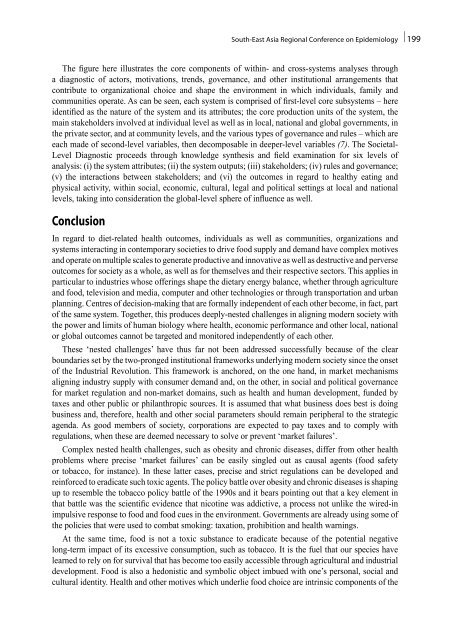South-East Asia Regional Conference on Epidemiology
South-East Asia Regional Conference on Epidemiology
South-East Asia Regional Conference on Epidemiology
Create successful ePaper yourself
Turn your PDF publications into a flip-book with our unique Google optimized e-Paper software.
<str<strong>on</strong>g>South</str<strong>on</strong>g>-<str<strong>on</strong>g>East</str<strong>on</strong>g> <str<strong>on</strong>g>Asia</str<strong>on</strong>g> <str<strong>on</strong>g>Regi<strong>on</strong>al</str<strong>on</strong>g> <str<strong>on</strong>g>C<strong>on</strong>ference</str<strong>on</strong>g> <strong>on</strong> <strong>Epidemiology</strong> | 199<br />
The figure here illustrates the core comp<strong>on</strong>ents of within- and cross-systems analyses through<br />
a diagnostic of actors, motivati<strong>on</strong>s, trends, governance, and other instituti<strong>on</strong>al arrangements that<br />
c<strong>on</strong>tribute to organizati<strong>on</strong>al choice and shape the envir<strong>on</strong>ment in which individuals, family and<br />
communities operate. As can be seen, each system is comprised of first-level core subsystems – here<br />
identified as the nature of the system and its attributes; the core producti<strong>on</strong> units of the system, the<br />
main stakeholders involved at individual level as well as in local, nati<strong>on</strong>al and global governments, in<br />
the private sector, and at community levels, and the various types of governance and rules – which are<br />
each made of sec<strong>on</strong>d-level variables, then decomposable in deeper-level variables (7). The Societal-<br />
Level Diagnostic proceeds through knowledge synthesis and field examinati<strong>on</strong> for six levels of<br />
analysis: (i) the system attributes; (ii) the system outputs; (iii) stakeholders; (iv) rules and governance;<br />
(v) the interacti<strong>on</strong>s between stakeholders; and (vi) the outcomes in regard to healthy eating and<br />
physical activity, within social, ec<strong>on</strong>omic, cultural, legal and political settings at local and nati<strong>on</strong>al<br />
levels, taking into c<strong>on</strong>siderati<strong>on</strong> the global-level sphere of influence as well.<br />
C<strong>on</strong>clusi<strong>on</strong><br />
In regard to diet-related health outcomes, individuals as well as communities, organizati<strong>on</strong>s and<br />
systems interacting in c<strong>on</strong>temporary societies to drive food supply and demand have complex motives<br />
and operate <strong>on</strong> multiple scales to generate productive and innovative as well as destructive and perverse<br />
outcomes for society as a whole, as well as for themselves and their respective sectors. This applies in<br />
particular to industries whose offerings shape the dietary energy balance, whether through agriculture<br />
and food, televisi<strong>on</strong> and media, computer and other technologies or through transportati<strong>on</strong> and urban<br />
planning. Centres of decisi<strong>on</strong>-making that are formally independent of each other become, in fact, part<br />
of the same system. Together, this produces deeply-nested challenges in aligning modern society with<br />
the power and limits of human biology where health, ec<strong>on</strong>omic performance and other local, nati<strong>on</strong>al<br />
or global outcomes cannot be targeted and m<strong>on</strong>itored independently of each other.<br />
These ‘nested challenges’ have thus far not been addressed successfully because of the clear<br />
boundaries set by the two-pr<strong>on</strong>ged instituti<strong>on</strong>al frameworks underlying modern society since the <strong>on</strong>set<br />
of the Industrial Revoluti<strong>on</strong>. This framework is anchored, <strong>on</strong> the <strong>on</strong>e hand, in market mechanisms<br />
aligning industry supply with c<strong>on</strong>sumer demand and, <strong>on</strong> the other, in social and political governance<br />
for market regulati<strong>on</strong> and n<strong>on</strong>-market domains, such as health and human development, funded by<br />
taxes and other public or philanthropic sources. It is assumed that what business does best is doing<br />
business and, therefore, health and other social parameters should remain peripheral to the strategic<br />
agenda. As good members of society, corporati<strong>on</strong>s are expected to pay taxes and to comply with<br />
regulati<strong>on</strong>s, when these are deemed necessary to solve or prevent ‘market failures’.<br />
Complex nested health challenges, such as obesity and chr<strong>on</strong>ic diseases, differ from other health<br />
problems where precise ‘market failures’ can be easily singled out as causal agents (food safety<br />
or tobacco, for instance). In these latter cases, precise and strict regulati<strong>on</strong>s can be developed and<br />
reinforced to eradicate such toxic agents. The policy battle over obesity and chr<strong>on</strong>ic diseases is shaping<br />
up to resemble the tobacco policy battle of the 1990s and it bears pointing out that a key element in<br />
that battle was the scientific evidence that nicotine was addictive, a process not unlike the wired-in<br />
impulsive resp<strong>on</strong>se to food and food cues in the envir<strong>on</strong>ment. Governments are already using some of<br />
the policies that were used to combat smoking: taxati<strong>on</strong>, prohibiti<strong>on</strong> and health warnings.<br />
At the same time, food is not a toxic substance to eradicate because of the potential negative<br />
l<strong>on</strong>g-term impact of its excessive c<strong>on</strong>sumpti<strong>on</strong>, such as tobacco. It is the fuel that our species have<br />
learned to rely <strong>on</strong> for survival that has become too easily accessible through agricultural and industrial<br />
development. Food is also a hed<strong>on</strong>istic and symbolic object imbued with <strong>on</strong>e’s pers<strong>on</strong>al, social and<br />
cultural identity. Health and other motives which underlie food choice are intrinsic comp<strong>on</strong>ents of the









